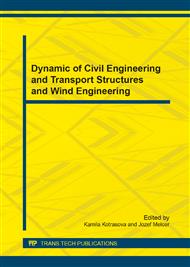p.70
p.76
p.81
p.86
p.92
p.96
p.100
p.104
p.110
Single Degree of Freedom Analysis of Steel Beams under Blast Loading
Abstract:
The paper deals with the analysis of steel beams subjected to blast load approximated as a one degree system of freedom (SDOF). It requires knowing the parameters of blast pressure wave, its effect on structure and the tools for the solution of dynamic analysis. The blast wave is estimated with linear decay and exponential decay using positive and negative phase. The results of SDOF model are compared with the corresponding experimental accelerations and strain time-histories. There is a described dynamic analysis for such structure.
Info:
Periodical:
Pages:
92-95
Citation:
Online since:
August 2014
Authors:
Keywords:
Price:
Сopyright:
© 2014 Trans Tech Publications Ltd. All Rights Reserved
Share:
Citation:


